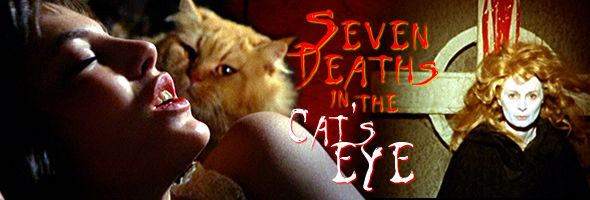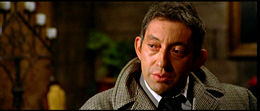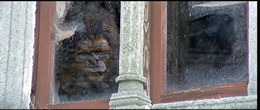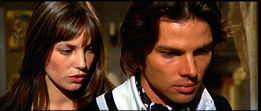
Colour, 1973, 95m. / Directed by Antonioni Margheriti / Starring Jane Birkin, Hiram Keller, Anton Diffring, Serge Gainsbourg, Dana Ghia, Francoise Christophe, Venantino Venatni / Blue Underground (US R0 NTSC) / WS (2.35:1) (16:9)
Though usually classified as a giallo, this daffy outing from director Antonio Margheriti works far better if one approaches it as an extension of his
Not usually known for his accomplished use of scope framing, Margheriti does an adequate job here coping with the demands of the super-wide framing; this is definitely not a film to watch pan-and-scanned by any means, making the Blue Underground DVD the only acceptable viewing option. Every scene is stuffed with sumptuous gothic details, though the sloppy use of artificial zooms on certain shots results in a few grainy, ugly, blown-up inserts that seriously disrupt the otherwise smooth fabric of the film. (Just watch Corringa's early arrival by carriage, which is spoiled by ridiculous phony close-ups.) The DVD does an exceptional job of dealing with this tricky material and looks light years ahead of that eyesore Prism tape from the 1980s. A non-anamorphic, less accurately letterboxed DVD from Dagored is also available under the Italian title of La morte negli occhi del gatto (with English subtitles for the alternate Italian track), but it's hardly worth the trouble. The Blue Underground disc only contains one extra, which is still more than one would expect for this fairly obscure title; co-writer Giovanni Simonelli offers an amusing interview entitled "Murder He Wrote" in which he discusses his working relationship with the late Margheriti, who pops up at the end in archival footage for a funny explanation of his "Anthony M. Dawson" credit on most of his films.
If you're of the opinion that any horror film could be improved tremendously by the addition of a rampaging gorilla named James, then Seven Deaths in the Cat's Eye is the movie for you. After a moody prologue in which a slashed cadaver is tossed down some cellar steps
 and devoured by rats, our story commences with the arrival of pretty young Corringa (pop chanteuse Birkin) at her family's remote Scottish castle. There she has dinner with a colorful assortment of eccentrics including her mother Alicia (Ghia), a sinister married doctor (Diffring) which a penchant for busty young women, and her handsome but incredibly rude distant cousin Lord James (Keller of Fellini Satyricon fame). Unfortunately the reunion turns out to be short-lived when mom turns up dead that night, and a nosy inspector (French music legend Gainsbourg) appears after the funeral to uncover the culprit. Meanwhile the aforementioned insane ape wanders the hallways, Corringa and her cousin decide to start making the beast with two backs for no apparent reason, and the killings continue, all under the watchful eye of the family's pet cat who has a habit of creeping into people's beds and hissing at them. Could it all be related to a family curse involving vampires and kitties? Or is the evildoer all too human?
and devoured by rats, our story commences with the arrival of pretty young Corringa (pop chanteuse Birkin) at her family's remote Scottish castle. There she has dinner with a colorful assortment of eccentrics including her mother Alicia (Ghia), a sinister married doctor (Diffring) which a penchant for busty young women, and her handsome but incredibly rude distant cousin Lord James (Keller of Fellini Satyricon fame). Unfortunately the reunion turns out to be short-lived when mom turns up dead that night, and a nosy inspector (French music legend Gainsbourg) appears after the funeral to uncover the culprit. Meanwhile the aforementioned insane ape wanders the hallways, Corringa and her cousin decide to start making the beast with two backs for no apparent reason, and the killings continue, all under the watchful eye of the family's pet cat who has a habit of creeping into people's beds and hissing at them. Could it all be related to a family curse involving vampires and kitties? Or is the evildoer all too human?
 atmospheric '60s gothic classics like Castle of Blood and The Virgin of Nuremberg (so much so that the latter's Riz Ortolani score turns up again here with alarming frequency). The whodunit aspects are handled well enough thanks to the large cast of characters and hefty body count (complete with bright red housepaint trying to pass for blood), and the usual murder mystery tropes (hidden passageways, dark family secrets, etc.) get a thorough workout. God only knows whether anyone intended to film to actually frighten anyway; the title feline is far too fluffy and cuddly to inspire any dread, but it's a catchy visual gimmick all the same. Of course, the biggest draw here is the insane cast; Birkin and Gainsbourg (the team responsible for the notorious chart-topper "Je t'aime moi non plus") barely get any time together onscreen, but good old Serge has a riotous dubbed Scottish accent that gives some much-need oomph to his interrogation scenes.
atmospheric '60s gothic classics like Castle of Blood and The Virgin of Nuremberg (so much so that the latter's Riz Ortolani score turns up again here with alarming frequency). The whodunit aspects are handled well enough thanks to the large cast of characters and hefty body count (complete with bright red housepaint trying to pass for blood), and the usual murder mystery tropes (hidden passageways, dark family secrets, etc.) get a thorough workout. God only knows whether anyone intended to film to actually frighten anyway; the title feline is far too fluffy and cuddly to inspire any dread, but it's a catchy visual gimmick all the same. Of course, the biggest draw here is the insane cast; Birkin and Gainsbourg (the team responsible for the notorious chart-topper "Je t'aime moi non plus") barely get any time together onscreen, but good old Serge has a riotous dubbed Scottish accent that gives some much-need oomph to his interrogation scenes.  Usually cast as villains, Diffring gets to be a bit more ambiguous here and obviously has fun indulging in some steamy sex scenes, which were probably more rewarding for him than the viewer.
Usually cast as villains, Diffring gets to be a bit more ambiguous here and obviously has fun indulging in some steamy sex scenes, which were probably more rewarding for him than the viewer.
